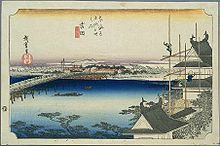- Yoshida-juku
-
 Yoshida-juku dans les années 1830, tel que représenté par Hiroshige dans les Cinquante-trois Stations du Tōkaidō
Yoshida-juku dans les années 1830, tel que représenté par Hiroshige dans les Cinquante-trois Stations du Tōkaidō
Yoshida-juku (吉田宿, Yoshida-juku?) était la 34e des 53 stations du Tōkaidō de la route du Tōkaidō. Elle était située dans la ville de Toyohasi, dans la préfecture d'Aichi, au Japon. Elle se trouvait à 287 km du départ de la route, au pont de Nihonbashi, à Edo, à 6,1 km de la station de Futagawa-juku, vers l'est, et 10,5 km de Goyu-shuku, vers l'ouest.
Sommaire
Histoire
Yoshida-juku fut créé en 1601, et fut donc une shukuba, une station d'étape sur la route du Tōkaidō dès la création de celui-ci cette même année. La station s'étendait à peu près sur 2,6 km et était à la fois la ville fortifiée du château de Yoshida[1], et une ville portuaire. C'était l'une des plus importantes stations de la route du Tōkaidō, et était également bien connue pour ses meshimori onna[1].
Selon un recensement effectué en 1802, les voyageurs trouvaient à leur disposition dans la station 2 honjin, une annexe de honjin, et 65 hatago. La ville comprenait au total quelque 1 000 bâtiments et comptait une population de 5 000 à 7 000 habitants.
Pendant l'ère Meiji, la station de Toyohashi fut construite dans un village avoisinant, ce qui eut pour conséquence de permettre à la région entourant Yoshida-juku de commencer à se développer en tant que ville.
Notes et références
- Yoshida-juku to Goyu-shuku sur le site japan-city.com (consulté le 11 décembre 2007)
Bibliographie
- (en) Patrick Carey, Rediscovering the Old Tokaido:In the Footsteps of Hiroshige, Global Books UK, 2000 (ISBN 1901903109)
- (en) Reiko Chiba, Hiroshige's Tokaido in Prints and Poetry, Tuttle, 1982 (ISBN 0804802467)
- (en) Jilly Traganou, The Tōkaidō road: traveling and representation in Edo and Meiji Japan, Routledge, 2004 (ISBN 9780415310918)
- Gabriele Fahr-Becker, L'Estampe japonaise, Taschen, 2006 (ISBN 978-3-8228-2057-5)
- Gisèle Lambert et Jocelyn Bouquillard, Le Tōkaidō d'Hiroshige, Bibliothèque de l'image, 2002 (ISBN 2-914239-69-6)
Articles connexes
Wikimedia Foundation. 2010.
